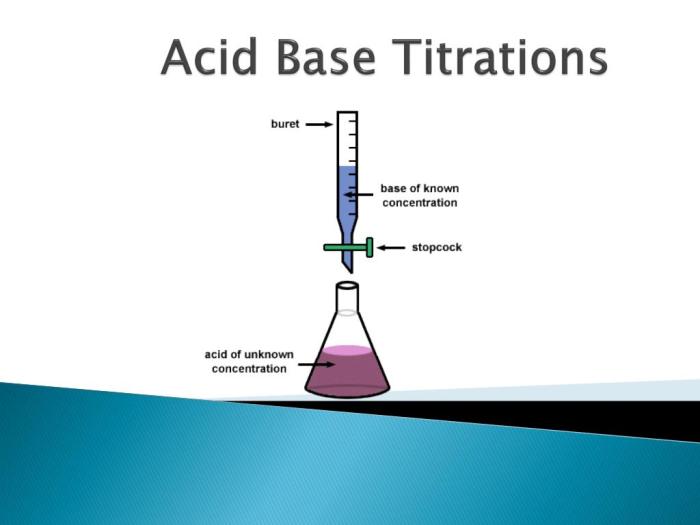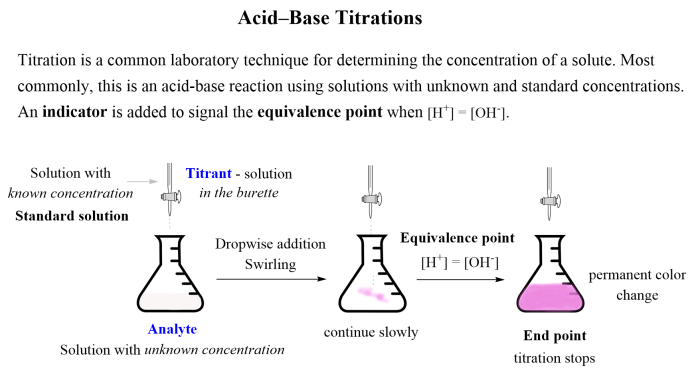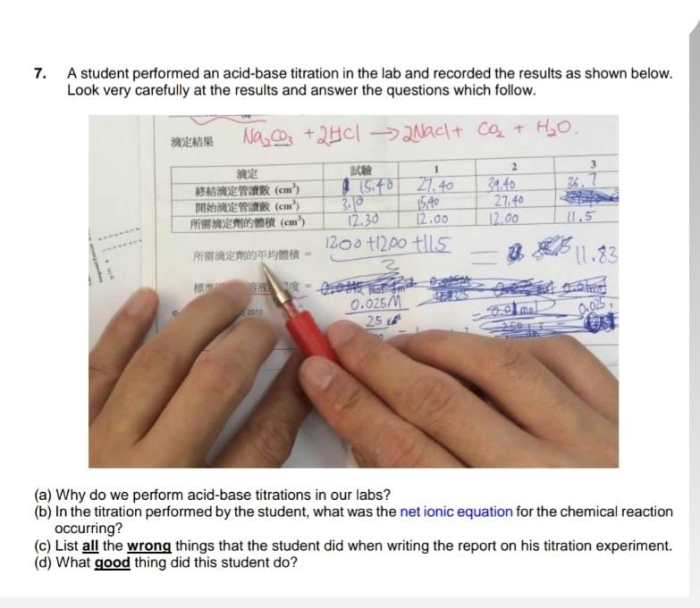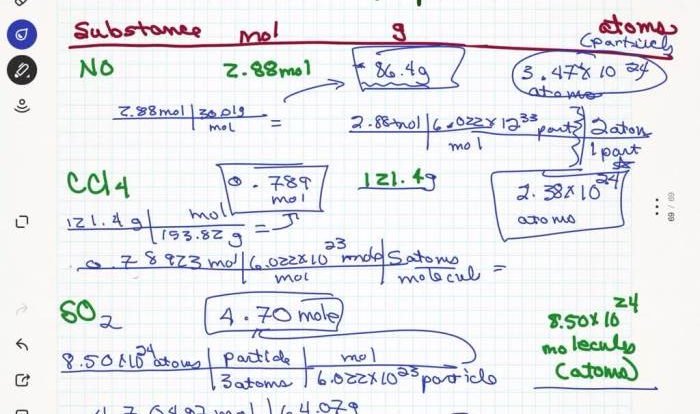Welcome to the world of acid-base titrations! This comprehensive guide, with ‘acid base titration lab answers’ at its core, will take you on an intriguing journey through the fascinating world of chemistry. Get ready to uncover the secrets of this fundamental laboratory technique and master the art of determining unknown solution concentrations with precision.
In this guide, we’ll delve into the intricacies of acid-base titrations, exploring their significance in various scientific disciplines. We’ll equip you with a thorough understanding of the materials and equipment involved, guiding you through the step-by-step procedure with clarity. Data analysis will become a breeze as we simplify the calculations and provide practical examples.
Plus, we’ll uncover potential sources of error and empower you with strategies to minimize their impact.
Introduction

Acid-base titration is a fundamental technique in chemistry that involves the gradual addition of a known concentration of acid or base to a solution of unknown concentration until the reaction reaches a specific endpoint. The endpoint is the point at which the moles of acid or base added are chemically equivalent to the moles of base or acid present in the unknown solution.
Acid-base titrations play a crucial role in various fields, including:
- Analytical Chemistry:Determining the concentration of unknown acids or bases in solutions.
- Industrial Chemistry:Controlling the pH of solutions in manufacturing processes, such as in the production of pharmaceuticals and food.
- Environmental Chemistry:Measuring the acidity or alkalinity of environmental samples, such as water, soil, and air.
li> Clinical Chemistry:Determining the concentration of analytes in biological fluids, such as blood and urine.
Materials and Equipment

Conducting an acid-base titration requires a specific set of materials and equipment, each playing a crucial role in ensuring accurate and precise measurements.
The following is a comprehensive list of essential items, along with their functions and uses:
Burette
- A burette is a graduated glass tube with a stopcock at the bottom. It is used to accurately dispense a known volume of liquid, typically the titrant, into the titration flask.
- The burette is filled with the titrant solution to a specific starting point, and the volume is recorded.
- As the titrant is dispensed into the titration flask, the volume is carefully monitored, and the end point is determined when the reaction is complete.
Titration Flask
- A titration flask is a conical-shaped flask used to hold the analyte solution, which is the solution being analyzed for its concentration.
- The titration flask is typically made of glass and has a wide opening to allow for easy addition of the titrant and other reagents.
- The volume of the titration flask should be appropriate for the expected volume of titrant required to reach the end point.
Indicator
- An indicator is a substance that changes color at or near the equivalence point of a titration.
- The indicator is added to the titration flask before the titration begins, and it helps to signal the end point by changing color.
- Different indicators are available for different types of acid-base titrations, and the appropriate indicator should be chosen based on the specific reaction being performed.
Pipette
- A pipette is a laboratory tool used to accurately measure and transfer small volumes of liquid.
- Pipettes are available in various sizes and types, depending on the volume of liquid to be measured.
- In acid-base titrations, pipettes are often used to transfer the analyte solution into the titration flask.
Balance
- A balance is used to accurately weigh the analyte before preparing the analyte solution.
- The balance should be calibrated regularly to ensure accurate measurements.
- The accuracy of the balance is crucial for obtaining precise results in the titration.
Erlenmeyer Flask
- An Erlenmeyer flask is a conical-shaped flask with a narrow neck and a flat bottom.
- Erlenmeyer flasks are commonly used to prepare the analyte solution before transferring it to the titration flask.
- The wide opening of the Erlenmeyer flask allows for easy mixing of the analyte solution and other reagents.
Magnetic Stirrer
- A magnetic stirrer is a laboratory device used to stir liquids using a rotating magnetic field.
- In acid-base titrations, a magnetic stirrer is used to continuously stir the solution in the titration flask.
- Stirring helps to ensure that the reactants are thoroughly mixed, which leads to a more accurate and precise titration.
Procedure
The procedure for performing an acid-base titration involves several key steps:
Before beginning, ensure you have gathered all the necessary materials and equipment. Wear appropriate safety gear, including a lab coat, safety glasses, and gloves.
Preparing Solutions
- Prepare a known concentration of acid solution (the titrant) using a volumetric flask and analytical balance.
- Measure an accurately known volume of the unknown base solution (the analyte) using a graduated cylinder or pipette.
Using the Buret
- Rinse the buret with the titrant solution to remove any impurities.
- Fill the buret with the titrant solution, ensuring there are no air bubbles present.
- Record the initial volume of the titrant in the buret.
Titrating the Solution
- Slowly add the titrant solution from the buret to the analyte solution while swirling the flask continuously.
- Observe the color change of the indicator or monitor the pH using a pH meter.
- Continue adding the titrant until the endpoint is reached, indicated by a distinct color change or pH value.
- Record the final volume of the titrant used.
Recording Data
- Record the initial and final buret readings accurately.
- Calculate the volume of titrant used by subtracting the initial reading from the final reading.
- Note any observations made during the titration, such as color changes or pH readings.
Data Analysis
Data analysis in acid-base titration involves calculating the unknown solution’s concentration using the titration data. The titration data is recorded in a table, with the volume of the titrant added and the corresponding pH or indicator color change noted.
Calculating Concentration
The concentration of the unknown solution can be calculated using the following formula:
Cunknown= (C titrantx V titrant) / V unknown
Where:
- C unknownis the concentration of the unknown solution
- C titrantis the concentration of the titrant
- V titrantis the volume of the titrant added
- V unknownis the volume of the unknown solution
Titration Data Organization
The titration data is typically organized in a table, as shown below:
| Volume of Titrant Added (mL) | pH or Indicator Color Change |
|---|---|
| 0.00 | Initial pH or color |
| 1.00 | pH or color at 1 mL |
| 2.00 | pH or color at 2 mL |
| … | … |
| Equivalence Point | pH or color at equivalence point |
Sources of Error: Acid Base Titration Lab Answers

Acid-base titrations are generally accurate and precise, but several factors can introduce errors. Understanding these sources of error is crucial to minimize their impact and ensure reliable results.
Acid-base titration labs are a common part of chemistry classes. If you’re looking for the answers to your acid-base titration lab, you can find them online. One helpful resource is the amsco world history answer key . This website provides a comprehensive list of answers to acid-base titration lab questions.
It’s a great resource for students who are struggling with this topic.
Errors in acid-base titrations can arise from various sources, including:
Measurement Errors
- Inaccurate Burette Readings:Incorrectly reading the burette volume can lead to significant errors. Ensure the burette is clean, properly calibrated, and read at eye level.
- Incomplete Drainage:Failure to drain the burette completely before starting the titration can result in an overestimation of the titrant volume.
Indicator Errors
- Endpoint Uncertainty:The color change of the indicator may not be sharp, leading to uncertainty in determining the equivalence point. Use indicators with a clear color change or consider instrumental methods like potentiometric titration.
- Indicator Concentration:The concentration of the indicator should be low enough to not affect the pH of the solution significantly.
Solution Errors
- Impurities:Impurities in the analyte or titrant can interfere with the titration reaction, leading to inaccurate results.
- Temperature Effects:Temperature changes can affect the equilibrium of the titration reaction and the volume of the solutions. Conduct titrations at a constant temperature or apply temperature corrections.
Human Errors
- Incorrect Calculations:Mistakes in calculating the concentration of the analyte or the equivalence point can introduce errors.
- Spills and Losses:Accidental spills or losses of solution during the titration can affect the accuracy of the results.
To minimize these errors, it is essential to:
- Use calibrated and accurate equipment.
- Follow the titration procedure carefully.
- Perform multiple titrations to ensure reproducibility.
- Consider instrumental methods for greater accuracy.
Applications
Acid-base titrations have diverse applications in various industries, offering precise and reliable solutions to practical problems.
In the chemical industry, titrations are crucial for quality control and product development. They determine the concentration of acids or bases in solutions, ensuring compliance with specifications and optimizing production processes.
Food and Beverage Industry
In the food and beverage industry, titrations play a vital role in ensuring product quality and safety. They measure the acidity or alkalinity of products, which is critical for taste, shelf life, and compliance with regulatory standards. For instance, in winemaking, titrations determine the acidity of the must to adjust it to the desired level, ensuring optimal fermentation and wine quality.
Pharmaceutical Industry
In the pharmaceutical industry, titrations are essential for drug development and quality control. They determine the purity and potency of active ingredients, ensuring the efficacy and safety of medications. Titrations also help in the formulation of drugs, optimizing their stability and effectiveness.
Environmental Monitoring, Acid base titration lab answers
Acid-base titrations are widely used in environmental monitoring to assess water quality. They measure the pH of water bodies, indicating the presence of pollutants or changes in environmental conditions. Titrations also help determine the concentration of specific ions, such as chloride or sulfate, which can impact aquatic life and ecosystem health.
Question & Answer Hub
What is the primary purpose of an acid-base titration?
To determine the unknown concentration of an acid or base solution by reacting it with a solution of known concentration.
What is the equivalence point in an acid-base titration?
The point at which the moles of acid and base are equal, resulting in a neutral solution.
How can errors be minimized in acid-base titrations?
By using standardized solutions, calibrating equipment, and carefully following the experimental procedure.


